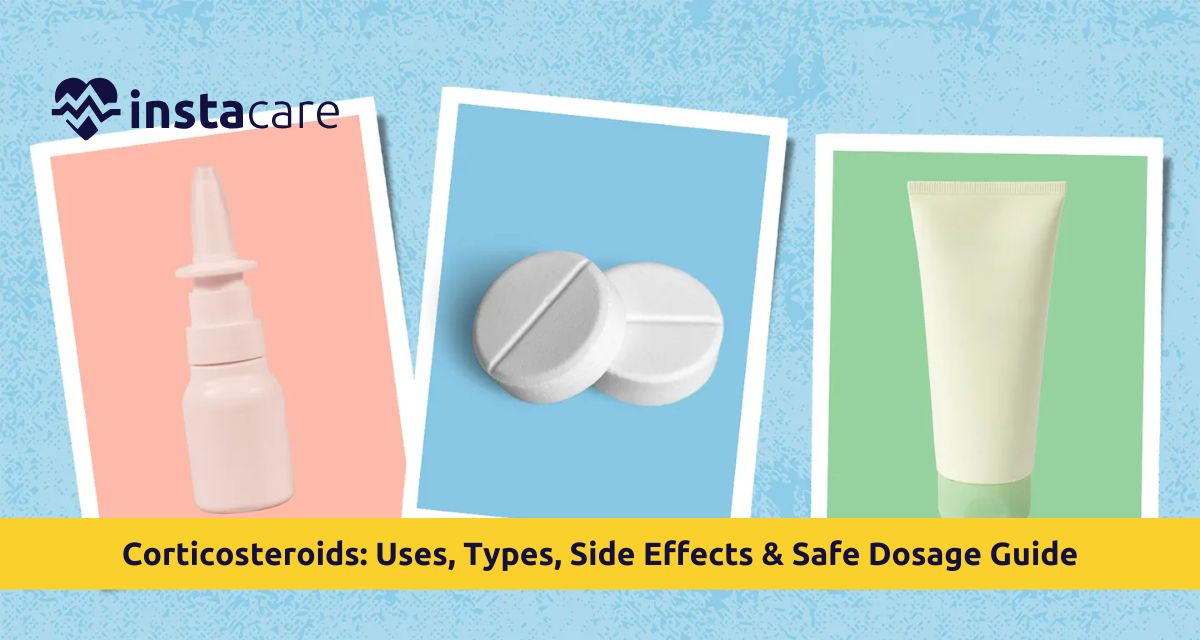Corticosteroids are incredibly powerful drugs that suppress inflammation and are utilized on an unimaginably wide variety of disease. However your disease is, asthma, eczema, arthritis, or autoimmune disease, corticosteroids might be on the list. But with their value come side effects, especially when they're misused.
This guide will provide you everything related to corticosteroid for inflammation, their use, types, and correct doses to potential side effects, as well as to how you can use them safely. If you think about medications such as oral corticosteroids, creams, or injections, then you have to know these drugs better to use them effectively and safely.
What are corticosteroids?
Corticosteroids are synthetic imitations of your hormone cortisol, which is secreted from your adrenal gland. Cortisol is how your body keeps inflammation rolling, the immune system, blood pressure,
metabolism, and stress response. Corticosteroid medication mimics those effects and are prescribed to fight against the over-inflammation of your body. They are not like anabolic steroids, the most used drugs in attempting to gain muscle. And corticosteroids vs steroids, medicinal treatment, and medicinal abuse.
Types of Corticosteroids
They have a numerous number of types of corticosteroids, which are made to use in many medical ailments or methods of delivery. The most common ones are the following:
- Oral corticosteroids: They are swallowed and are used to treat mainly severe to moderate inflammation. Examples of which include prednisone, dexamethasone, and methylprednisolone.
- Inhaled corticosteroids: They are utilized in Corticosteroids for asthma and are given directly to the lung to inhibit airway inflammation. Examples of which include budesonide and fluticasone.
- Topical corticosteroids: Corticosteroids for skin conditions like eczema, psoriasis, or dermatitis. Hydrocortisone and betamethasone are the most commonly used corticosteroid cream.
- Injectable corticosteroids: Injected into muscle and joint to suppress disease inflammation such as arthritis or backache.
- Nasal and ocular corticosteroids: To suppress allergic rhinitis or eye inflammation, e.g., fluticasone nasal spray or prednisolone eye drops.
In order to be of greatest use and not cause harm, the proper method must be learned.
General Uses of Corticosteroids
Corticosteroids are highly nonspecific to administer. Physicians utilize them in the management of an enormous range of inflammatory and immune illnesses. A few examples of their most nonspecific indications include:
- Corticosteroids for dermatoses Such as eczema, contact dermatitis, psoriasis, and allergic rashes.
- Corticosteroids to manage asthma and chronic obstructive pulmonary disease Ease airway inflammation and facilitate breathing.
- Autoimmune disorders Employed in corticosteroids applied in autoimmune disorders such as lupus, multiple sclerosis, and rheumatoid arthritis to suppress the hyperactivity of the immune response.
- Allergic disorders Such as very severe allergic disorders such as anaphylaxis or angioedema.
- Gastrointestinal disorders Such as Crohn's disease, or ulcerative colitis when applied to suppress bowel inflammation.
- Endocrine disorder Such as Addison's disease, where the body is unable to produce enough natural cortisol.
These Corticosteroid drugs list are typically lifesaving when used rightly and under the direction of a doctor.
Safe Dosage & Best Practice of Corticosteroids
Dose safety counts when using corticosteroids. Misusing or abusing them causes severe side effects. Some general guidelines are as follows:
- Follow just what your doctor advises: Don't vary the dose by yourself. Even when the symptoms resolve, reducing corticosteroids temporarily may lead to adrenal insufficiency.
- Use the minimal dose needed: This reduces your risk of Long-term effects of corticosteroids. Physicians also start with a higher dose and reduce it slowly as the disease gets better.
- Short term is best: Corticosteroids are merely to be used for a few weeks to several months of recent illness.
- Follow-up is needed with long-term: Chronic disease needs follow-up visits to check blood pressure, bone mineralization, and blood sugar.
- Take corticosteroids with food: Decreases stomach upset and ulcers.
Inform your health care provider of any change in drug therapy.
Side Effects of Corticosteroids
Side effects can be caused by corticosteroids, particularly with prolonged or high dose therapy. Although not every patient will be given them, since there is a risk, they can be detected early and treated. Most common side effects are:
- Weight increase and water retention: More often a result of increased appetite and water and salt retention.
- Irritability or mood swings: Corticosteroids influence mental state, and in a few instances, induce irritable mood or mood swings.
- Elevating blood sugar and blood pressure, especially with long-term use, and inducing diabetes or high blood pressure.
- Bruising and thinning skin: More with long-term corticosteroid ointment.
- Risk of infection: Increased since corticosteroids suppress the immune system.
- Bone loss and osteoporosis: Risk with long-term oral corticosteroids.
If any of these side effects occur, inform your doctor right away. They can change your dose or use others in place.
Tips for Cutting Corticosteroid Side Effects
If corticosteroids are part of your regimen, here's how to minimize their risks:
- Take drugs precisely as ordered: Never alter your Corticosteroids dosage ourself or stop cold.
- Eat healthy Proper nutrition: A diet rich in calcium, potassium, and low sodium intake to combat weight gain, bone loss, and water retention.
- Exercise: Daily exercise to maintain strong bones, prevent weight gain, and sound mental health.
- Maintain your health: Regular check-ups to track blood pressure, blood sugar, and bone density.
- Use topical preparations carefully: Use only as much as you require and only for a short time on sensitive surfaces like your face or groin.
- Take supplements: Your doctor might recommend that you take calcium and vitamin D so that you can potentially be able to keep your bone cover.
By following the above steps, you will be able to have corticosteroid benefit with less side effect.
Conclusion
Corticosteroids are the best of the best for the best drug one can employ to fight inflammation and autoimmune disease. No matter how they get delivered, corticosteroid cream, inhaler, tablet, or injection, they're one of the four building blocks of modern medicine. great power, however, brings with it great responsibility, especially with dosing, surveillance, and managing side effects.
By learning about the types, use, and risk, and by working with your health care provider, you can be successful in utilizing corticosteroids as therapy. Educate yourself, speak up, and don't hesitate to ask questions about medication.
Please book an appointment with the
best General Physician in Lahore, Karachi, Islamabad, and all major cities of Pakistan through
InstaCare, or call our helpline at 03171777509 to find the verified doctor for your disease.

